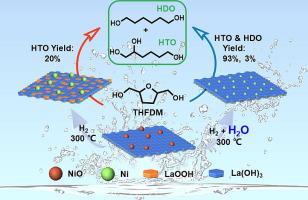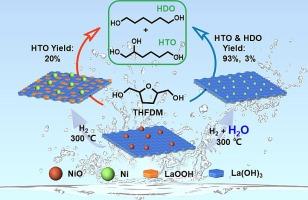Water-assisted preparation of Ni/La(OH)3 catalyst for efficient catalytic C-O bond hydrogenolysis of tetrahydrofuran-dimethanol
IF 6.5
1区 化学
Q2 CHEMISTRY, PHYSICAL
引用次数: 0
Abstract
Due to easy dehydration of La(OH)3 to LaOOH by thermal treatment, it is challenging to prepare highly efficient Ni/La(OH)3 catalyst for hydrogenolysis reactions. Herein, Ni/La(OH)3 (Ni/La-2) catalyst is prepared by thermal reduction of NiO/La(OH)3 in hydrogen flow with vaporized water, while La(OH)3 is partially dehydrated to LaOOH without water vapor affording Ni/(La(OH)3 + LaOOH) (Ni/La-1). Ni/La-2 displays 93 % and 3 % yields of 1,2,6-hexanetriol (HTO) and 1,6-hexanediol (HDO) respectively towards C-O hydrogenolysis of tetrahydrofuran-dimethanol (THFDM) in batch reactor and high stability (200 h) in fixed-bed reactor, which is the best among the reported catalysts to the best of our knowledge. Ni/La-2 possesses pure La(OH)3 as support, enhanced dispersion of Ni species and abundant Niδ+-O-La interfaces in comparison to Ni/La-1, which results in the exceptional catalytic performances in C-O hydrogenolysis of THFDM. A fine control of reaction temperature and time is required to optimize the yields HTO and HDO in hydrogenolysis of THFDM over Ni/La-2. The water-assisted preparation method provides a new perspective for the preparation of La(OH)3 supported metal catalysts.


水辅助制备用于高效催化四氢呋喃-二甲醇 C-O 键氢解的 Ni/La(OH)3催化剂
由于 La(OH)3 很容易通过热处理脱水为 LaOOH,因此制备用于氢解反应的高效 Ni/La(OH)3 催化剂具有挑战性。在此,Ni/La(OH)3(Ni/La-2)催化剂是通过在氢气流中用汽化水热还原 NiO/La(OH)3,而 La(OH)3 在无水蒸气的情况下部分脱水成 LaOOH,得到 Ni/(La(OH)3+LaOOH)(Ni/La-1)。在间歇反应器中,Ni/La-2 对四氢呋喃-二甲醇(THFDM)的 C-O 加氢分解分别产生了 93% 和 3% 的 1,2,6-己三醇(HTO)和 1,6-己二醇(HDO);在固定床反应器中,Ni/La-2 具有很高的稳定性(200 小时)。与 Ni/La-1 相比,制备的 Ni/La-2 以纯 La(OH)3 为载体,镍的分散性增强,镍δ+-O-La 界面丰富,因此在 THFDM 的 C-O 氢解过程中具有优异的催化性能。要优化 Ni/La-2 氢解 THFDM 的 HTO 和 HDO 产率,需要对反应温度和时间进行精细控制。水辅助制备方法为制备 La(OH)3 支持的金属催化剂提供了一个新的视角。
本文章由计算机程序翻译,如有差异,请以英文原文为准。
求助全文
约1分钟内获得全文
求助全文
来源期刊

Journal of Catalysis
工程技术-工程:化工
CiteScore
12.30
自引率
5.50%
发文量
447
审稿时长
31 days
期刊介绍:
The Journal of Catalysis publishes scholarly articles on both heterogeneous and homogeneous catalysis, covering a wide range of chemical transformations. These include various types of catalysis, such as those mediated by photons, plasmons, and electrons. The focus of the studies is to understand the relationship between catalytic function and the underlying chemical properties of surfaces and metal complexes.
The articles in the journal offer innovative concepts and explore the synthesis and kinetics of inorganic solids and homogeneous complexes. Furthermore, they discuss spectroscopic techniques for characterizing catalysts, investigate the interaction of probes and reacting species with catalysts, and employ theoretical methods.
The research presented in the journal should have direct relevance to the field of catalytic processes, addressing either fundamental aspects or applications of catalysis.
 求助内容:
求助内容: 应助结果提醒方式:
应助结果提醒方式:


